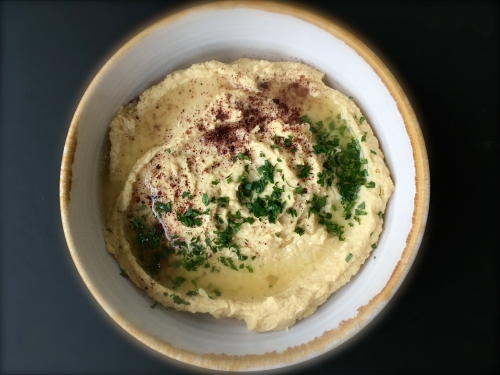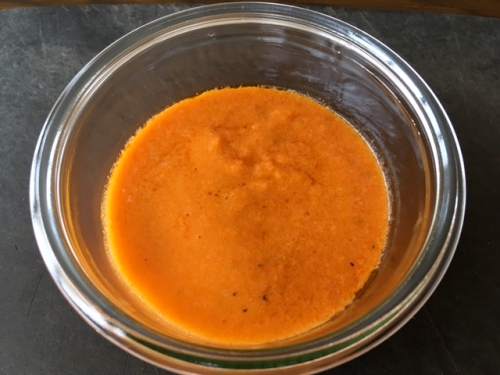A February/March Lunch/Dinner
Hummus
Fish Soup with Rouille
Crêpes with Crème Fraîche, Citrus, and Rosemary Honey
Still in the middle of winter in Vancouver this year, what I feel like most these days is soup and citrus – the warming, comforting richness of a fish soup with the refreshing tang of citrus to finish. Here is a lunch menu (which could easily be used for a dinner) that I made recently. I was aiming for something a bit special yet casual, to welcome visiting family from Boston.
Hummus
We go through heaps of hummus in our household, and I have most often resorted to buying it to keep up with consumption. My working theory is that if something can be easily purchased and the product is as good as home-made, why bother making it at home?
Good hummus can be bought at any supermarket and until now I have not been satisfied with the homemade version. My hummus has not been as creamy as I like it and it has had an underlying bitter taste. But I recently learned two techniques that have me preferring my own version. First, using canned chickpeas, drain and rinse as usual, then slip off and discard the skins. OK, if this seems too tedious, you can skip this step. But the second change is a huge improvement which I encourage you to try: make your own tahini. It’s surprisingly easy to do if you have a food processor. The end result is a richer and more flavourful tahini that is not bitter.
There are of course many options for serving hummus: with pita, crackers, vegetables for dipping, etc. But I happened to find some Italian taralli snacks at Zara’s Deli (photo below) at Granville Island Market. While the hole in the middle makes dipping a bit tricky, the flavour combination and the texture of the crackers is terrific with hummus.
1 can chick peas, drained and rinsed
1-2 cloves garlic, grated
juice of 1 lemon (about 2 tablespoons)
2 tablespoons tahini
½ teaspoon cumin
¼ teaspoon cayenne, or to taste
salt and pepper to taste
cold water (about ½ cup)
sumac, parsley, drizzle of olive oil, as desired for garnish
bagel chips, crackers or taralli snacks (below)
If you have time, remove the skins from the drained and rinsed chickpeas. This is not absolutely necessary, but will result in a smoother texture. Place chickpeas in the bowl of the food processor and add the garlic, lemon juice, tahini, cumin and cayenne. Process, scraping the bowl periodically, until the mixture is very smooth. Pour in cold water slowly through the feed tube, until the hummus reaches the consistency that you like, and continue to process for about 1 minute. Add salt and pepper to taste. Garnish as desired, cover and refrigerate. Hummus is best served at room temperature so make sure to remove it from the refrigerator at least 1 hour before serving.
Tahini
1 cup sesame seeds
2-3 tablespoons extra virgin olive oil
Heat a heavy saucepan over medium high heat and add the sesame seeds. Shake or stir frequently until they are evenly toasted. They should be a golden brown. Watch closely as they burn easily. Remove from the heat and cool slightly.
Place seeds in a processor and process for about 1 minute. Scrape down the sides of the bowl and add 2 tablespoons olive oil through the feed tube. Process into a smooth paste, scraping down the sides. Add more oil if needed to reach the desired consistency. Pour into a container and add a bit of olive oil, just to cover the surface. Store in the refrigerator.
Fish Soup with Rouille
Some of the elements of this dish can be prepared in advance. My recommendation would be to make or purchase the fish stock and make the rouille a couple of days in advance. That leaves the final cooking of the fish in the soup and making the croûtes for the same day. This recipe is adapted from Epicurious.
Soup Base
1 large leek, washed, green part coarsely chopped and white part thinly sliced (divided)
5 tablespoons olive oil, divided
1 onion, chopped
2 ribs celery, coarsely chopped
2 carrots, coarsely chopped
3 cloves garlic, smashed
¼ teaspoon saffron threads, crumbled
2 bay leaves
1 teaspoon dried hot red pepper flakes, or to taste
28oz. tin peeled Roma tomatoes
2 tablespoons tomato purée
2 cups dry white wine
1½ quarts fish stock, purchased or recipe below
Heat 3 tablespoons of oil in a large heavy pot over moderate heat, then add leek greens, onion, celery and carrots and cook until the vegetables begin to soften. Add the garlic and cook, for another 3 minutes. Add saffron, bay leaves and red pepper flakes and cook, stirring, 2 minutes. Add tomatoes and purée and cook, stirring, another 3-4 minutes. Add the wine and simmer, uncovered, until the liquid is reduced by about half. Stir in stock and bring to a boil. Reduce heat and simmer, uncovered, for about 30 minutes. Strain into a bowl and discard solids. Store for up to 2 days, covered in the refrigerator.
Fish Stock
1 tablespoon vegetable oil
2 lbs. white fish bones and trimmings
1 large onion, sliced
1 medium fennel bulb, coarsely chopped
¼ lemon juice
1 teaspoon salt
7 cups cold water
1 cup white wine
Cook the fish bones and trimmings, onion, fennel, parsley, lemon juice and salt in a large heavy pot over medium heat. Add the water and wine and bring to a boil, skimming the froth that rises to the surface. Simmer, uncovered, for 20 minutes and then strain, discarding the solids and reserve the stock. This can be done up to 2 days in advance. Makes 1½ quarts.
Rouille
2 red peppers
6 cloves garlic, minced
1 teaspoon salt
1 jalepeno pepper, seeded and chopped
½ cup fresh bread crumbs
¾ cup extra virgin olive oil
2 tablespoons fresh lemon juice
½ teaspoon black pepper
Lay the red peppers on their sides directly on gas burners and turn the flame on high. Or, put them on the rack of a broiler pan about 2” from the heat. Roast, turning with tongs, until the skins are blackened. Transfer to a bowl, cover and let steam for about 20 minutes. Remove the skin and seeds from the peppers and tear flesh into large pieces. Place them in the bowl of a food processor, and add the minced garlic, salt, chopped jalepeno and bread crumbs. Purée, then with the motor running slowly add the oil, lemon juice and pepper, blending until very smooth. Remove and store in an air tight container in the refrigerator for up to 3 days.
Bread Croûtes
1 loaf unsliced sourdough or country bread
2 tablespoon butter
salt to taste
Remove crust from the loaf and tear inside into roughly 3” pieces. Brush with the remaining 2 tablespoons olive oil and grill on all sides, or bake at 350ºF until lightly toasted. You want the outside toasted and the inside soft. Set aside until ready to serve the soup.
To Finish
1 lb. white fish, cut into 1” cubes (I used cod, but look for whatever is freshest, any white fish will be great)
rouille
1 tablespoon chopped fresh oregano
1 tablespoon chopped fresh flat leaf parsley
Heat 2 tablespoons of butter in a 4 quart heavy pot over moderate heat. Cook the white part of the leek until it begins to soften. Add the soup base and bring it to just boiling. Season to taste with salt. Add cubed white fish and simmer until fish is just opaque, about 2 minutes. Stir in ½ cup of the rouille. Put bread croûtes in warm soup plates and ladle soup over top. Garnish with oregano and parsley and serve remaining rouille on the side.
Crêpes with Crème Fraîche, Citrus Compote and Rosemary Honey
I was in the mood for crêpes and since citrus fruit is so good right now, I searched online for an interesting combination. I found what I was looking for at What Katie Ate: Food and Photography. I used my own crêpe recipe and tweaked the compote. The original recipe suggests cooking the citrus for part of the time with the juices and sugar, but I found that the fruit fell apart that way, so my instructions keep the fruit separate. Just make sure you drain it well and collect all of the juices for the syrup.
Crêpe Batter
1 cup flour
2 tablespoon sugar
pinch salt
2 eggs
1½ cups milk
½ teaspoon vanilla
1 tablespoon unsalted butter, melted
softened butter, for cooking
Citrus Compote
6 large navel oranges
2 red grapefruits
2 tablespoons fine sugar
½ cup mint leaves, julienned
Rosemary Honey
1 cup liquid honey
2 sprigs rosemary
1 cup crème fraîche and mint leaves, for serving
Crème Fraîche can be made ahead (or you can purchase it) by combining 1 cup whipping cream and 2 tablespoons buttermilk in a jar. Shake well and leave at room temperature, covered, until it thickens, about 24 hours depending on how warm your kitchen is. Refrigerate until ready to use.
Prepare the citrus compote: Cut the top and bottom from the fruit, then place on a chopping board and using a sharp knife, cut away all of the peel and pith. Take the fruit in your hand and over a bowl, cut each inner segment away from the membrane, letting them fall into the bowl. Squeeze out the remaining juice from the membrane into the same bowl.
Strain the juices into a large frying pan, reserving the citrus segments. Heat the juices with 2 tablespoons of sugar and simmer until the mixture reduces by ⅔ and is syrupy. Stir in the orange segments and the mint leaves and set aside. Can be made a few ours in advance and kept at room temperature.
For the rosemary honey: Place honey and rosemary in a small saucepan, bring to a simmer and cook over medium, heat without boiling for about 5 minutes to infuse the flavour. Transfer to a jar and reserve. Warm a bit before serving.
For the crêpes: In a bowl, combine flour, sugar and salt. Add eggs, ½ cup of milk, vanilla, and whisk until smooth. Gradually add remaining milk, stirring constantly. Whisk in melted butter.
Preheat a 6” crêpe pan over medium heat. When the pan is hot, brush with butter.
For each crepe, pour about 2 tablespoons of batter in the centre of the skillet. Tilt pan to spread batter evenly until it covers the entire bottom of the pan. When the edge peels off easily and begins to brown, turn the crêpe with a spatula. Continue cooking for about 10 seconds and then remove from pan. Place cooked crêpes on a plate as you go. Cover with aluminum foil to keep them from drying. Crêpes can be made 1 day in advance, well-wrapped and covered, in the refrigerator. Warm in a 350ºF oven for about 20 minutes before assembling.
To Serve: Place a warm crêpe on a plate, place some citrus compote on one quarter and top it with a spoonful of crème fraîche. Fold the crêpe over the filling and then into quarters. Depending on appetites, you can offer 1-2 per person. Finish the presentation with a drizzle of rosemary honey and mint leaves.











 I can’t remember a time when food was not an important part of my day. From an early age, I observed and participated in the kitchens of my mother and two grandmothers.
I can’t remember a time when food was not an important part of my day. From an early age, I observed and participated in the kitchens of my mother and two grandmothers.